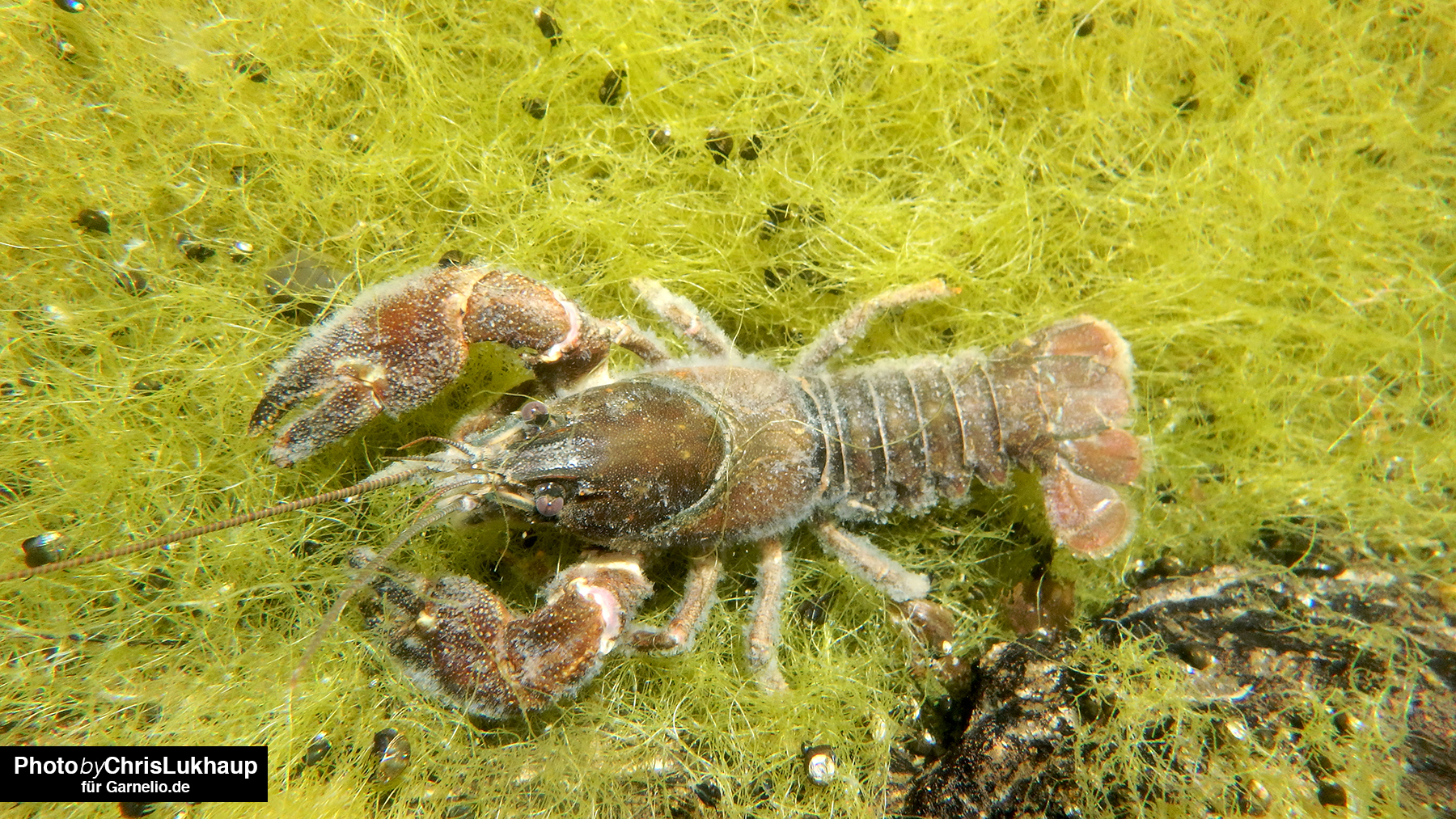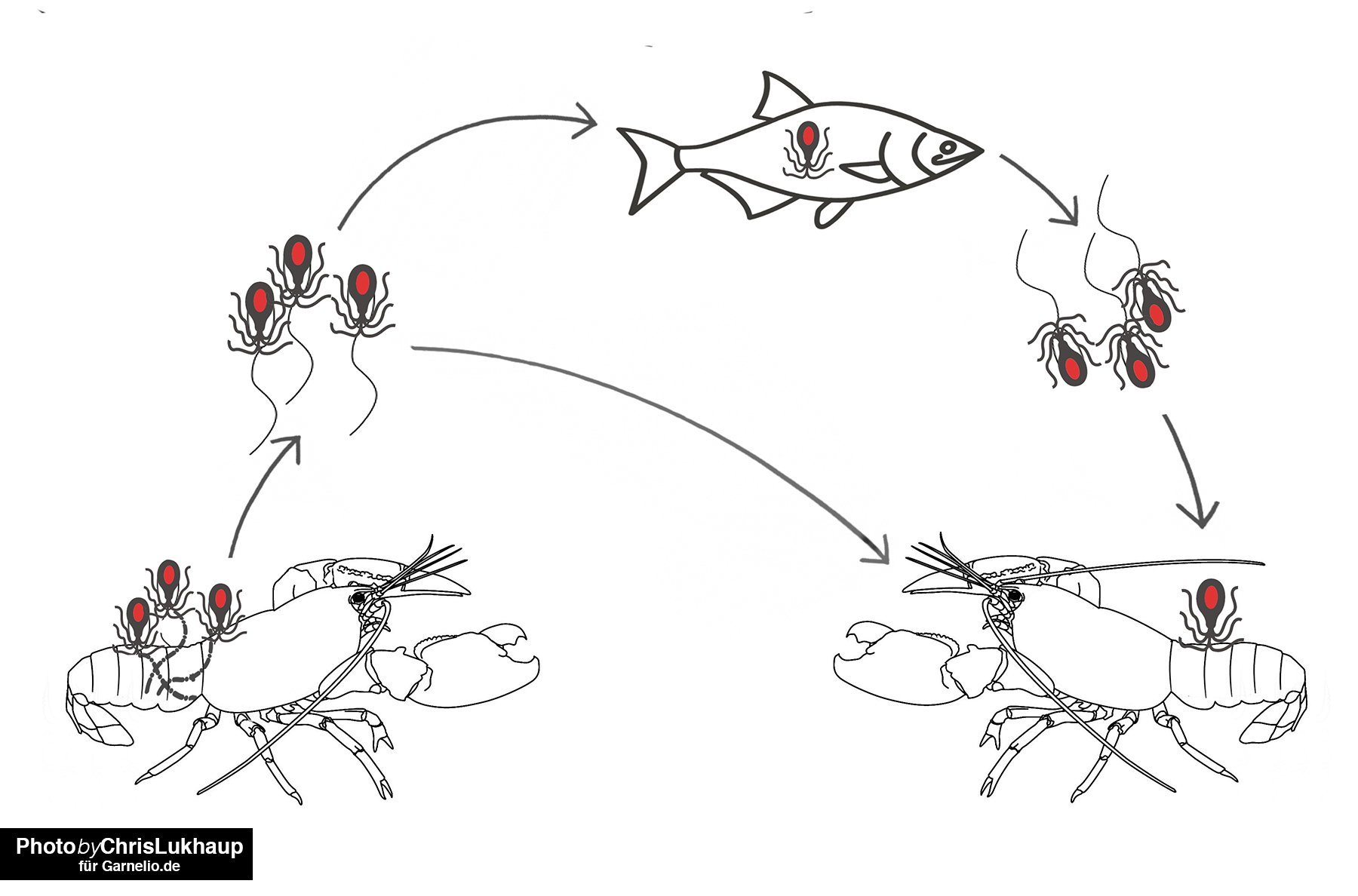The crayfish plague in the aquarium?
The dreaded crayfish plague originated in America. It is caused by an egg fungus (oomycete), also called algal fungus: Aphanomyces astaci. This fungus has had a devastating effect on European crayfish populations, thus explaining the trivial name "crayfish plague" for this disease.
Crayfish from North America are immune
Crayfish plague is disease that affects all crayfish species from around the world and is fatal to most of them, with the exception of species from North America and Central America. American crayfish have co-evolved with this algal fungus and in the process have been able to establish defense responses. They have the ability to isolate the pathogen of the crayfish plague in their bodies in such a way that it cannot cause any damage. Only severely weakened animals in which this immune reaction no longer functions can also become ill. However, all other crayfish species are susceptible to the crayfish plague. Once infected, the disease progresses unstoppably and rapidly. It is fatal in all cases, infectious as hell, and wipes out entire populations within a few days.
If the unicellular fungus had not been introduced to Europe, we would probably know nothing about it - it is not noticeable in the areas of origin because the American crayfish have developed strategies for coexistence. In America itself, crayfish plague is not an issue even today because it simply does not affect native populations at all.

Introduced in the 19th century
The pathogen was most likely introduced from North America as early as the mid/late 19th century. At that time, American crayfish were imported and released as edible crayfish. These animals were more attractive as edible crayfish than the native species because they reproduced more often and therefore promised a higher "harvest". The disease first appeared in Lombardy in northern Italy. From 1860 onwards, reports of mass deaths of native crayfish in the field can be found throughout Europe. This phenomenon continues to occur into our own time.
How can you tell that a crayfish has crayfish plague?
When a crayfish begins to scratch itself almost continuously with its walking legs, especially on the eyes, the gills and the underside, and when it loses its escape reflex, extreme caution is required. Such a crayfish must be taken out of the group immediately! As the disease progresses, an animal infected with crayfish plague may gradually lose its limbs (autotomy). It becomes increasingly uncoordinated, shows signs of paralysis and keels over more often. This course takes only hours to a few days. Shortly before death, the egg fungi are seen as a white coating on the eyes and claw joints. At these sites, they preferentially break out of the dying host to seek a new victim. The fungus cannot form permanent stages.

Reproduction by actively swimming spores
Without a host, Aphanomyces astaci cannot survive for long for this reason, so after breaking out of the host, the pathogen forms a spore ball that produces vast numbers of zoospores. They have two flagella for active locomotion in the water. The infestation of the aquarium, pond or water body is complete by then at the latest. The infection pressure is extremely high due to the enormously high number of spores produced by the crayfish plague pathogen.
This swarm spore goes swimming in search. If it finds organic material, it docks and reforms into a cyst. To do this, it sheds its two flagella.
Infection of the crayfish
Once it has landed on a crayfish, the cyst first produces enzymes that penetrate the shell and then forms hyphae that grow into the crayfish. A North American crayfish can encapsulate and enclose this mycelium - so nothing happens to it. The next time it molts or fights, these encapsulations can rupture and new spores are released. Thus, an infected American crayfish becomes a source of pathogens even though it shows no symptoms of crayfish plague at all and looks perfectly healthy itself. Even if the crayfish dies from another cause, the crayfish plague pathogen will seek out new hosts.
It is only possible to reliably identify an infected American crayfish with laboratory testing.
A crab from Europe, Australia or Asia does not have this ability to encapsulate the crab plague pathogen. It is overgrown by the fungus and dies. There are now very isolated populations of stone crayfish in the wild in Austria, which may have developed resistance to the algal fungus - but this is only a drop in the bucket, the vast majority of European, Australian and Asian crayfish populations still have nothing to resist the crayfish plague.
Host failure and the effects on the spore
However, if the zoospore does not land on a crayfish, but on other organic material, it has to re-form the flagella it has shed and start searching again. This takes a toll on its substance. Flagella can be re-formed only 3-4 times, after which the spore dies.

Quarantine of four weeks
For each process the spore needs about 5 days. So after 20 days an empty aquarium should be free of spores. If you want to be absolutely sure, wait four weeks, then even an aquarium in which American crayfish were previously kept will be free of the crayfish plague.
Ways of transmission of the crayfish plague
Unfortunately, the pathogen of crayfish plague is not exclusively transmitted by crayfish. The spores move in free water and also sit on organic material. Therefore, they can also be transmitted with other living creatures from the water - plants, snails, fish, mussels, shrimp and so on, as well as through the water itself. Wet nets and also wet hands are such a transmission route.
Therefore, if one wants to keep American crayfish and crayfish from Asia, Australia or Europe in an aquarium, one must ensure that nothing is exchanged back and forth between aquariums (or that a four-week quarantine is observed). The water circuits must be strictly separated. It is best to provide each aquarium with its own net - this makes sense anyway to exclude the possibility that other pathogens such as bacteria or viruses are transmitted in addition to the crayfish plague.
Measures to take when keeping American crayfish
To protect our last native populations of crayfish, we must also take measures when keeping American crayfish. Under no circumstances should they be released into the wild, nor should they be kept in a garden pond - crayfish migrate amazing distances. Also, the water from an aquarium with an American crayfish should not be allowed to enter natural waters. Quite conscientious keepers use it for watering flowers.
In the meantime, there is evidence that American crayfish populations in the hobby are not as heavily infested as was to be feared - however, this is not a free pass for careless behavior. As before, it is impossible to detect a crayfish carrier without laboratory testing, and crayfish plague - once outbreaked - has an absolutely catastrophic effect on native crayfish as well as the very popular Cherax from Indonesia and Australia, and is always fatal. So basically, unless you have an American crayfish from a safe and reliably negative-tested source, you should take the precautions listed above.


Keine Amerikaner
Vielen Dank für die Information, es waren einige interessante Dinge drin.
Persönlich ist es mir leider unbegreiflich, weshalb man unbedingt mit dieseer Gefahr spielen muss.
Gefahr für das eigene Aquarium und den Besatz und lettendlich für unsere Umwelt.
VG
OJ
Haltungsverbot
Leider wurde vergessen zu erwähnen, dass gemäss der Liste invasiver gebietsfremder Arten von unionsweiter Bedeutung das Halten, die Zucht und der Verkauf bzw. von folgenden Arten in der EU verboten ist (VERORDNUNG (EU) Nr. 1143/2014 DES EUROPÄISCHEN PARLAMENTS UND DES RATES, KAPITEL II, PRÄVENTION, Artikel 7):
Eriocheir sinensis (Wollhandkrabbe), Orconectes limosus (Kamberkrebs ), Orconectes virilis (Viril-Flusskrebs), Pacifastacus leniusculus (Signalkrebs), Procambarus clarkii (Roter Amerikanischer Sumpfkrebs), Procambarus fallax f. virginalis (Marmorkrebs)
Weitere Infos:
http://eur-lex.europa.eu/legal-content/DE/TXT/HTML/?uri=CELEX:32014R1143&from=EN -> Infos zu Haltungsverbot
https://neobiota.bfn.de/unionsliste.html
Warum bietet ihr weiterhin Amerikanische Krebse an , obwohl ein Verkaufsverbot besteht?
Warum bietet ihr weiterhin Amerikanische Krebse an , obwohl ein Verkaufsverbot besteht?
Antwort Guido Kinnigkeit
Hallo Guido,
Wir bieten ausschließlich Arten an die in Deutschland nicht verboten sind.
Liebe Grüße,
Farschad Farhadi
Toller Bericht
Ich glaube die meisten Leute wissen das garnicht daher finde ich es sehr empfehlenswert diesen Artikel zu lesen. Das dieses Haltungsverbot mancher Arten nicht erwähnt wurde ist natürlich schade aber gibt keinen Sternabzug.
Prima Artikel, aber eine frage hätte ich.
Hi
angenommen ein CPO hätte die Krebspest gehabt und ist mittlerweile verstorben. wie lange muss ich warten bis ich in das Aquarium andere Krebse setzen kann.
Das Aquarium ist in Betrieb, Aktuell sind da noch Garnelen drin. Daher kann ich das Aquarium nicht schliessen und sicherheitshalber desinfizieren.
Ich glaube zwar nicht das meine CPO die Krebspest hatten, da ich die von Euch gekauft habe aber sicher wissen kann man das ja nicht.